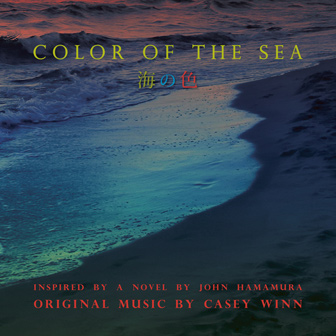Color of The Sea

Purchase
Track Listing
1. Prelude (3:37)
Part One
2. Snow Dance (2:18) Cello Solo No. 1
3. Bamboo May (2:04)
4. Butterflies (2:26)
5. Scrubber (2:00)
6. Pig Gun October (1:34)
7. Sayonara December 1938 (1:44)
Part Two
8. Japanese American Girl (2:07)
9. Obon July (1:21) Cello Solo No. 2
10. Love Secret (2:21)
11. Samurai Jitterbug (2:28)
12. Two Dreams (3:15) Violin Solo No. 1
13. Touched (1:53) Cello Solo No. 3
14. Streamer and Doves (2:47)
Part Three (Entr'acte)
15. Misa, June, 1940 (1:50)
16. Fireflies and Hollow August, 1940 (2:54) Violin solo No. 2
17. Two San's and Ki May, 1941 (2:45) Cello Solo No. 4
18. Lightning, Wind and Fireworks (2:41)
19. Tanabata (1:45)
20. Kempeitai July (1:42)
21. A Kiss for Uncle Nobutaro (2:44) Violin Solo No. 3
22. Home, 1941 (1:09)
23. Lucky Seven (2:08) Violin Solo No. 4
Part Four
24. Japs Sunday December 7, 1941 (3:06)
25. Running the Course (1:31)
26. Bowstrings (2:03) Violin and Cello Duet
27. Okinawa, July, 1945 (1:42)
28. Honor, 1945 (1:32)
29. Test and Manuscript (1:53)
Part Five
30. Bunji's Ashes (2:02)
31. Flash August (2:09) Cello solo No. 5
32. Atonement and Letter (2:23)
33. Honura December and Survivors, 1946 (3:24)
34. Epilogue: Torii, June 1947 (1:39)
Liner Notes
Synopsis for the Color the Sea
Coming of age in the 1930s and 40s, Sam, a Kibei, feels the pull of his native homeland, the lure of the ancient martial arts training that has shaped his character, and the mother and siblings he left back home in Japan. But his adolescence in Hawaii and young adulthood in California have also given him a taste for American life, most notably in the personification of Keiko, a Japanese girl whose honesty and innocent love astound him.
Sam and Keiko's relationship is torn apart when she and her family are sent to Japan and he is drafted into the US. Army. Sam struggles to maintain his sense of identity and soon follows Keiko to the Japan where the witness Hiroshima and other tragic events of the times. Can he be a samurai warrior and an American patriot at the same time? Does he have the courage to fight a war and return with a heart still open to love?
Composer's Notes
The idea of using an Asian theme for a music project has really been in progress for over five years. In 2002 shortly after I completed “A.I.: Supertoys Last All Summer Long”, I had several projects in mind and a Japanese/American story was defiantly on the top list-do projects but I decided to postpone until I found the proper subject matter to work with. At the moment I didn’t realize it would be 5 years later before I would actually start working on it. After completing my previous album “Metamorpho” I knew then the time was ripe to start working on my Japanese project. From mid December to about mid January 2007 I researched various novels and stories. First I had the idea of a ancient Japanese fairy tale but none really inspired me musically. I even had a serious thought of doing the famous “The Tale of Genji, the 11th century Japanese classic but decided it was too complex to deal with. After considering one or two other ones I finally found John Hamamura’s 2006 novel “Color of the Sea”. His chapter titles immediately intrigued me. Merely reading about the book and seeing John’s chapter titles was enough to inspire me to do a score. The Process was challenging of course but the subject matter was just what I was looking for. I knew early on the score would call for rich orchestral colors with various violin and cello solos throughout. Again, John’s chapter titles really stirred my musical imagination to give it its epic, diverse and expansive length of nearly 80 minutes.
小説「海の色」のあらすじ
1930年代から40年代にかけて青年時代を過ごした帰米2世のサムは、祖国日本への郷愁にかられる。日本に残した母や兄弟に思いを寄せる一方、日本古来の武道に強く魅了されるサム。武道の鍛錬は、彼の人格形成に大きく影響を与える。同時にハワイやカルフォルニアで過ごす思春期・青年期を通して、サムはアメリカ生活の素晴らしさも経験する。そんな中、彼は日本人の少女「けい子」と出会う。
彼女の誠実さと純真無垢な愛は、サムの心を激しく揺さぶる。けい子とその家族の日本への送還、そしてサムの徴兵によって、引き裂かれる二人の関係。自らのアイデンティティに苦悩するサムは、後にけい子を追って渡った日本で、広島の原爆などの悲劇を目の当たりにする。「サムライ」として、また「アメリカ人愛国者」として人は同時に生きられるのか。戦争に参加する勇気を持ったまま、人を愛する心を持つことができるのであろうか。
作曲者あとがき
「アジア」をテーマにしたこの音楽プロジェクトには、過去5年を構想に費やしました。2002年、「A.I.: Supertoys Last All Summer Long」が完成の後、新しいプロジェクトのアイディアはいくつかあって、中でも日系アメリカ人の物語はトップリストに挙がっていました。しかし、その時は然るべき題材にめぐり合っておらず、その時期が来るまでじっと待つことに決心したのです。当時は、実際に作業にかかるまでまさか5年もかかるとは思いもよりませんでした。そして、前作のアルバム「Metamorpho」の完成直後、とうとう日本をテーマにしたプロジェクトに取り掛かる時期が来たことが分かったのです。2006年12月中旬から翌年1月中旬にかけて、さまざまな小説や物語をリサーチしました。当初、私は古代日本のおとぎ話を題材にと考えていましたが、残念ながら音楽的に刺激されるものに出会えませんでした。11世紀の古典「源氏物語」を取り上げることも真剣に考えたのですが、複雑すぎる物語は今回のプロジェクトには適さないと判断しました。その他いくつかの候補を経てジョン・ハマムラ著「海の色」(原題 “Color of the Sea”)(2006年出版)に出会ったのです。そして、中の章題にすぐさま興味を惹かれました。その小説について書かれた記事を読み、章題を見ただけで、私の創作意欲をかき立てるのに十分でした。もちろん、作曲の工程は難しくやりがいのある作業でしたが、題材そのものはまさしく私が求めていたものでした。バイオリンやチェロのソロが彩る豊かなオーケストラの音色が楽譜に必要なことは、早い段階から考えていました。繰り返しになりますが、著者の章題がまさしく私の音楽のイマジネーションを刺激し、壮大な80分の作品に仕上げることができました。
Production Credits
United Media Productions, Ltd.
Presents
A Yokohama-East Asia Pacific Production
Color of the Sea
Inspired by the novel by
John Hamamura
Recorded at UMP Studios, August 26th & 27th 2007, Austin, Texas USA
Mastered at Barnstormers Studio, September 4th, Austin by
Bruce Newman
Art Direction and Graphic Design by
Brian Williams
Japanese Translations by
Saito Shizuka
Associate Producers
Barbara Ann Green and Michael Kintz
Digital Equipment by Sony
A & R Coordinator
Chad Canadey
Composed, Orchestrated, Engineered, Performed and Produced by
Casey Winn